StanChart CSR #4 : Sat 16 May 2015
0
We kicked off the first Bukit Brown Tour & Clean-Up Corporate Social Responsibility (CSR) event of 2015 on 16 May 2015 with a record number of 50+ volunteers. The volunteer sign-ups were overwhelming and the organizing team had to cap the group size due to logistical limitations.
Heritage preservation is certainly a CSR theme that is catching on at Standard Chartered Bank! Read on to find out what one of our volunteers experienced…
By Hemanshu Parekh
(photo credit : compilation of StanChart & All Things Bukit Brown)
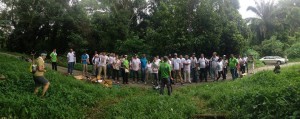
Pictured: Supported by 35 volunteers when this initiative first started out in 2014, the Bukit Brown Tour & Clean-Up effort is seeing growing interest from Bank staff and has hit a record of 50+ volunteers at the fourth session held on 16 May 2015.
New to this event, most of the volunteers signed up for this event not knowing what to expect. At the end of the day, it turned out to be one of the most rewarding and satisfying CSR effort we have ever experienced!
The day started with volunteers assembling at the gates of Bukit Brown Cemetery, which was also the starting point of our tour of the heritage site. We were split in 2 groups – newbies and repeat volunteers. While repeat volunteers were taken on a tour route that included the nearby kampong (village), newbies like myself went on an “orientation” route, with Catherine as our guide.
Catherine – like all other guides –is a ’Brownie’ who is dedicated to conservation work and conducting tours for Bukit Brown. ’Brownies‘ have been investing their weekends on this project for over 3 years now.
Catherine started the session by giving us basic education on the cemetery and Chinese tombs.
The layout of Bukit Brown Cemetery, first followed a grid system, meticulously drawn by the British for the Chinese during colonial times. The cemetery is known as the “mother cemetery” as it also hosts the graves from other cemeteries which have been taken over by development.
As the resting place of many pioneers of Singapore, some of the bigger and elaborate tombs hold tremendously historical value, particularly since many Chinese tombs in China were destroyed during the Cultural Revolution.
The Chinese did not like the structured grid pattern laid down by the British, as that did not conform to the all-important Feng Shui or geomancy considerations for burial, such as elevation, the presence of water bodies, the direction the tomb faces, etc. Obviously, the stature and wealth of the deceased would determine whether the tomb could incorporate all the desirable Feng Shui elements. Historians have noted that while the initial tombs are laid out in a structured pattern, subsequent ones had more generous layouts – obviously Feng Shui took precedence over orderliness.
Standing beside a tomb, Catherine proceeded to explain the layout of typical Chinese tombs. The tombstones of Chinese tombs were actually the foot stones. At burial, the body was slightly elevated such that the head was higher than the feet. Tombs belonging to the Hokkiens, were constructed in a rounded shape so as to resemble a tortoise – which has positive Feng Shui connotations.
Granite was the most commonly used stones for constructing tombs, and they were sometimes imported from China for the purpose. Marble stones were also used at times.
Couple tombs always had the husband positioned on left and wife on the right. A pair of lion statues was usually installed as tomb guardians, where male lions were depicted with a foot standing on a ball, while female lions had a cub by its side. The “gender” positioning for tombs are male always on the left and female are always, right. The plot for tomb had to be purchased in advance and would cost about Straits$ 6 – 30 per plot in 1924.
As Singapore became an important trading port where many cultures intersect, some Chinese tombs incorporated non-Chinese cultural elements. Some tombs emulated aesthetic practices of the British like the use of decorative tiling. In the later years, tiles were imported from Japan and bore Asian- inspired designs –European tiles used abstract designs while Asian tiles featured auspicious motifs like flowers and fruits.
When we stopped by a majestic hill tomb, Millie, another guide, took over the story telling. This was her great grandfather’s resting place. About 4 years ago, she learnt that her great grandfather was laid to rest in Bukit Brown. She spent time researching his tomb and eventually located it in the vast cemetery. She then spent time restoring the tomb, which was overgrown with vegetation.
Her story is not an unique one – in recent years, a number of people have located the tombs of their ancestors through research and search, restored dignity to the forgotten tombs, reunited the living with the deceased and uncovered intriguing stories of the past. Often, the experience of locating one’s ancestors’ tomb is an emotional one. The amalgamation of numerous personal stories and anecdotes form a deep historical narrative for the heritage cemetery.
We saw another tomb where turban clad Sikhs statues took the place of the typical lion guardians. Years ago, one of the traditional professions that Sikhs took on was that of policemen and guards to the wealthy – and they were revered for their bravery and dependability. Hence, the erection of Sikh guardian statues was a way of paying homage to the Sikhs professionalism. There are to date 26 pairs of Sikh guardians found in Bukit Brown cemetery.
We came across a few tombs which had various mythical creatures as tomb guardians. We were told that in China, there were strict rules governing the use of mythical creatures as tomb guardians as they were reserved for government officials or even royalty. As the Chinese saying that goes “Far from the Emperor, Far from Judgment” – the Chinese in Singapore had the liberty of flaunting these rules without fearing the Emperor’s wrath.
The tour lasted almost one hour and ended at a clearing where an array of equipment were neatly laid on the grass for the second part of the event – tomb cleaning.
After a comprehensive safety briefing, we were split into 5 teams of 10 volunteers. The teams were tasked with different duties: 2 teams were assigned to heavy duty tomb cleaning work, which involved clearing dense overgrowth and tree cutting; 2 teams were tasked with clearing and cleaning tombs with moderate undergrowth; and one team was to pick up rubbish along the trails. I volunteered for the heavy duty work.
My team was tasked with cleaning the neglected tombs in the Cheang Hong Lim family cluster. There were a total of 8 tombs and half of them were almost completely covered by undergrowth, shrubs and small trees.
The task seemed daunting at first and the undergrowth was very thick, oftentimes colonised by unfriendly red ants. We gritted our teeth, picked up our equipment and started work under the guidance of veteran volunteers. After a while, we got the hang of the work, and progressed faster.
The first sense of satisfaction came when we hit concrete and uncovered the forecourt of the first tomb we worked on. After that, it became a drill: cut the shrubs and trees, clear the undergrowth, find the forecourt, then clear the vegetation off the forecourt and tombstone.
Teamwork was the order of the day, as we alternated between the tasks of cutting, cleaning and disposing of debris.
We were drenched in sweat and hard at work when we were told we had only 10 minutes left – time really went by quickly when you are engrossed in work! Not wanting to do slipshod work on the few remaining tombs, we doubled up our efforts like schoolboys during the last 10 minutes of their exams.
When we were done, we high-fived one another and admired our work with a strong sense of achievement and satisfaction. We took group photos and shared smiles and cheers with fellow volunteers and the Brownies. Some volunteers claimed that this was the most challenging and satisfying CSR ever. Most of us agreed it was definitely a unique, educational and satisfying experience!
We reached the end of the official activities and most volunteers left. A handful of us, who had not had enough, decided to take a final tour to the famous Ong Sam Leong tomb, reputed to be the biggest and most majestic in Bukit Brown. We reached the tomb after a 15 minute hike up a hill. The size of ten 3-bedroom HDB flats, it truly was a majestic tomb. The tomb belonged to yesteryear phosphate magnet Ong Sam Leong’s family. It was constructed with high quality granite, adorned with numerous intricate carvings (the stories behind the carvings could easily fill a book), and it even had a moat where once contained fishes! Our guide Claire highlighted that this is the only tomb that can be seen from Goggle Earth.
The day ended with us being a little more educated on history and exhausted from the laborious morning. Besides leaving with a tremendous sense of satisfaction for our heritage preservation work, I’m sure we also left with the blessings of the many pioneers resting on Bukit Brown!
********************************
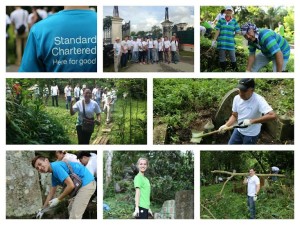
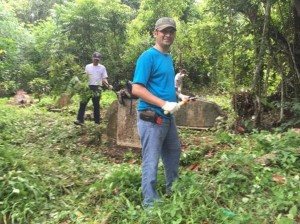
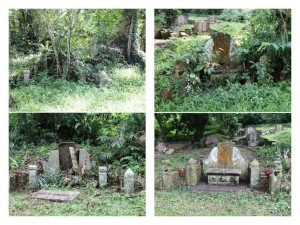
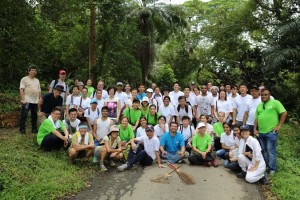

Comments